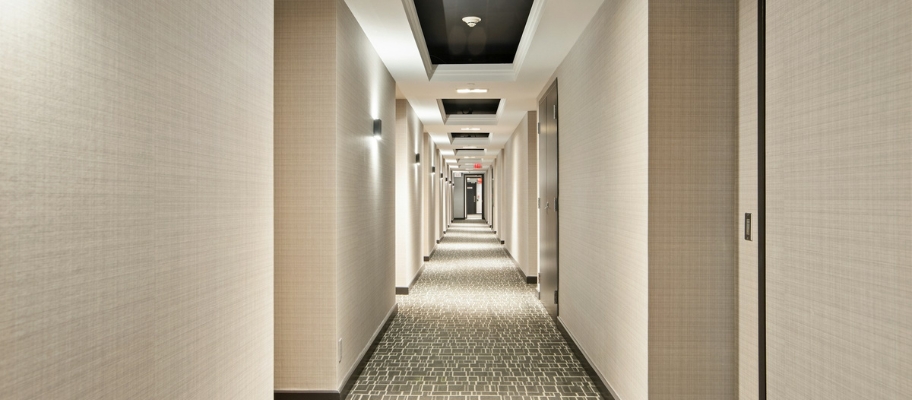We use cookies to give you the best possible experience. To accept cookies continue browsing, or view our Cookies Policy to find out more.
How Hotels Can Cut Energy Costs By Using Energy-Efficient Lighting

According to a survey of 50 UK hotels conducted by Defra, lighting accounts for approximately 8% of total energy consumption. With thousands of lights running 24/7 across rooms, hallways, lobbies, and outdoor areas, hotels have a major opportunity to cut costs and reduce their carbon footprint by adopting energy-efficient lighting solutions.
Oh, and take it from us. Our white bedding looks fantastic under the right lighting, whether that be artificial or natural light.
Anyway, let’s delve into some tips and statistics that show how hotels can cut costs and reduce their environmental impact by switching to more efficient lighting.
1. Switch to LED Lighting
Replacing traditional incandescent or fluorescent bulbs with LED (Light Emitting Diode) lights is one of the most effective ways to lower energy consumption.
LEDs:
- Consume at least 75% less energy than incandescent bulbs (U.S. Department of Energy).
- Last up to 50,000 hours—about 25 times longer than incandescent bulbs.
- Reduce cooling costs by producing significantly less heat.
The Prague Marriott Hotel reportedly achieved around a 58% reduction in lighting electricity consumption, simply by switching to more efficient bulbs. While Travelodge retrofitted 388 of its UK hotels with LED lighting between 2017 and 2020, which resulted in annual savings of approximately 20.2 GWh of energy.
2. Install Motion Sensors and Smart Controls
Hotels often leave lights on in unoccupied areas, leading to unnecessary energy waste. Motion sensor lighting can reduce electricity use in hallways, stairwells, and restrooms. Additionally, smart lighting systems with timers and dimmers can lead to an energy savings of by adjusting brightness levels based on occupancy and natural light.
A Candlewood Suites hotel successfully reduced their energy consumption by 30-35% (a saving of $3,000 a year) by introducing motion sensors combined with LED light bulbs.
This didn’t just turn off lights when nobody was in the room, it included an energy-management system that combined motion sensors and a door sensor to adjust the air conditioning temperature to a less energy intensive setting. When the guest returned to the room, it would automatically adjust back to the guest-determined setting
3. Utilise Daylight Where Possible
Maximising natural light can reduce lighting energy use by up to 75%, depending on the building’s design. Hotels can optimise daylight by:
- Installing large windows (particularly those facing south) and skylights in lobbies and conference rooms. Glass partitions in public areas allow daylight to flow freely between rooms too.
- Using light-reflecting wall colours and mirrors to enhance brightness.
- Integrating automatic blinds that adjust to daylight levels.
Don’t forget to have a regular window cleaning schedule for maximum daylight penetration. None of your guests would like to see grimy windows!

4. Choose Energy-Efficient Outdoor Lighting
Outdoor lighting for pathways, signage, and security can be a major energy drain. Using solar-powered lighting and LED floodlights with motion sensors can significantly reduce energy use. Photocells and timers can ensure that exterior lights operate only when needed.
5. Opt for Smart Energy Management
Hotels with smart energy management systems that adjust lighting based on occupancy see significant savings. This doesn’t just include things like smart room controls, but overall Building Management Systems that integrate with a hotel’s HVAC, lighting and other energy-consuming systems that optimise systems based on real-time needs. Basically, if a guest leaves their room then you don’t want to have systems wasting energy by still running when they’re not there.
- DoubleTree by Hilton Dartford Bridge cut energy costs by 65% by switching to a smart energy management system.
- Hilton Hotels overall saved over £770 million in energy costs over 10 years by implementing smart energy controls, including automated lighting.
The Bottom Line
Switching to energy-efficient lighting can reduce hotel electricity bills by 20-40%, significantly cutting operating costs and carbon emissions. By incorporating LED technology, motion sensors, daylight optimisation, and smart room controls, hotels can enhance guest comfort while contributing to a greener planet.
Vision Linens has been serving the hospitality industry for decades, so we like to think we know our stuff when it comes to helping you run the best hospitality business. Find out how we can help you in our comprehensive hotel bedding buying guide, or find out how to make your hotel more sustainable.






